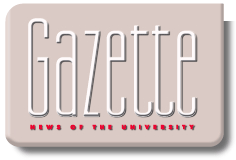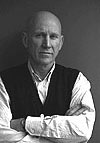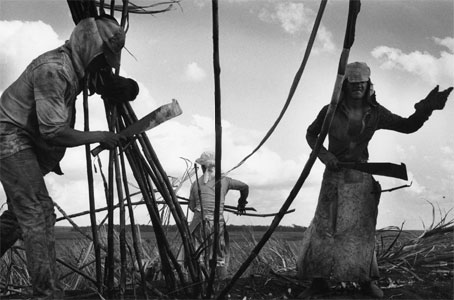|
|||
 |
• TRAX MEDICAL LINE SET TO OPEN |
||
| COMMENCEMENT 2003 | |||
“Lives change at this university,” said author and activist Terry Tempest Williams BS’79 MS’84 during her address at the 2003 Commencement ceremonies on May 2, the 133rd commencement at the U. Indeed, the lives of more than 6,800 graduates changed this spring as they received diplomas and congratulations from the University of Utah. The total number of degrees—which includes bachelor’s, master’s, and doctoral degrees—is 2,275 more than was handed out a decade ago, evidence of the growing enrollments at Utah’s colleges and universities. The fields awarding the largest number of degrees were mass communication, business finance, psychology, and political science. The youngest bachelor’s degree recipient was 18, while the oldest was 66. The average age of bachelor’s degree recipients was 26, and their average grade point average was 3.20. Some of the 62 students who officially notified the University of their military deployment to serve in the Iraq war during the spring semester had to postpone graduation. Those students have been working with the University to determine how to complete required coursework. Graduates and Commencement attendees listened to Williams—and offered a standing ovation as she finished—and to student speaker Maren Harper, a graduate in political science and captain of the 2002 soccer team. The Rosenblatt Prize, a $40,000 faculty award that honors excellence in teaching, research, and administrative efforts, was presented to Sung Wan Kim PhD’69, Distinguished Professor of pharmaceutics and pharmaceutical chemistry and a Distinguished Professor of bioengineering. In addition, honorary degrees were awarded to Afton Bradshaw BA’47 MS’83, Bill Child BS’54, Tom Korologos BA’55, Al Thrasher, and Terry Tempest Williams. Several teaching, research, and service awards were also presented to faculty members in a wide range of disciplines. |
|||
| TRAX MEDICAL LINE SET TO OPEN | |||
|
The University hopes the extension will further ease traffic and parking congestion on campus. One-third of a new parking structure, located near the University South Campus station, will be used as a parkand- ride lot. Last spring, University students were asked to submit proposals for artwork to be placed at each of the three new stations. The chosen pieces include 12-foot steel sculptures by Yoshikazu Kono BS’01, a graduate student in architecture, for the University Medical Center station; two four-foot-square cubes of stainless steel and sandstone by Cody Dingus and James Nielson, design and architecture students, for the Fort Douglas station; and a brightly colored, mod-looking steel sculpture by J. Bernie Johnson, an art and art education student, for the University South Campus station. |
|||
| SALGADO SPEAKS | |||
|
On Sept. 23, Salgado will deliver this year’s Tanner Lecture on Human Values, at 8 p.m. at Gardner Hall. The lecture, a discussion with slides, will address art, globalism, and cultural instability, and is free and open to the public. The Tanner Lectures were established by Obert C. Tanner BA’29 JD’36 with the purpose of advancing and reflecting upon “the scholarly and scientific learning relating to human values.” Tanner—scholar, philanthropist, and founder of the O.C. Tanner Company—said, “I hope these lectures will contribute to the intellectual and moral life of mankind. I see them simply as a search for a better understanding of human behavior and human values.” Nine educational institutions around the world host the lectures: Oxford, Cambridge, University of California, Harvard University, University of Michigan, Princeton University, Stanford University, Yale University, and the University of Utah. Past lecturers have included Harold Bloom, Stephen J. Gould, Toni Morrison, and Wallace Stegner BA’30.
Susan Miller, professor of English and the chair of the Tanner Lecture committee, notes that Salgado’s work is especially appealing as an illumination of the growing complexity of international interactions. “We are very fortunate to have one of the five or six most accomplished living photographers speak about globalism, its intended outcomes, and, especially, its unintended results for local peoples,” she says. “In the best possible ways, his lecture and exhibit will demonstrate how art makes a persuasive intervention in public opinion.” Two panels will also be held in conjunction with Salgado’s lecture. One, “Social Photography, Globalism and the Environment,” will be Sept. 22 at 4 p.m. at the Utah Museum of Fine Arts and will include Salgado, Fred Richin, director of PixelPress, an online magazine, and Ken Light, social documentary photographer. Another, discussing broadly defined issues of globalism, will be held on Sept. 23 at noon in the Gould Auditorium and will include Salgado, Gil Loescher, senior fellow at the International Institute for Strategic Studies in London, Shifra Goldman, author of books and essays on Latin American art, and Lewis Gordon, fellow at the U's Wallace Stegner Center for Land, Resources and the Environment. For additional information, contact Rosemary Tanner at rosemary-tanner@excite.com. |
|||
 |
|||
| PARTNERS, IN THE PARK AND ELSEWHERE | |||
|
This summer season marked the kickoff of the “Partners in the Parks” program, sponsored by University/Neighborhood Partners and the Salt Lake City Parks Department. University/Neighborhood Partners (see Continuum, Winter 2002) is an initiative to increase collaboration between the U of U community and the communities on the west side of Salt Lake City. In April, the program celebrated the opening of its new home at 1060 South 900 West. The Partners in the Parks program offered an evening of family activities every Tuesday in one of Salt Lake City’s parks. Each evening was co-sponsored by a different Westside group and University unit, working together to plan a potluck dinner and things to do in the park, from children’s games to trail cleanups to sports. The get-togethers rotated among different parks from June to August, including Jordan, Westpoint, Sherwood, Riverside, and Poplar Grove parks. The variety of sponsoring groups—from neighborhood groups such as the Capital West Boys and Girls Club and the Northwest Recreation Center to University entities such as the Alumni Association and the Utah Museum of Fine Arts— ensured a wide range of activities and participants. Besides being a great way for families to enjoy Salt Lake’s summer evenings, Partners in the Parks helps Westside and University residents get acquainted. That’s part of the aim of University/Neighborhood Partners, which focuses on four broad areas: programs and services that serve youth, bridgebuilding, support for residentled initiatives, and neighborhood capacity-building in the areas of health, housing, employment, safety, and the environment. Visit www.partners.utah.edu to find out more. |
|||
| IN MEMORIAM | |||
|
Elaine Cannon, 81, BS’43, editor and writer. At the U, she was president of Chi Omega sorority and president of the University of Utah Associated Women. Ruth Hudson Hale, 94, Diploma’28, playwright and actor who helped start a network of family-owned theaters in California and Utah. Roger Kvamme Hanson, 70, director of libraries at the U from 1973 to 1995. Dean L. May, 65, professor of history who specialized in the social history of the American West. He was the recipient of the Ramona Cannon Award for Teaching Excellence in the Humanities. Allen M. Sievers, 84, professor of economics and chair of the economics department (1968-1971), and the recipient of the College of Social and Behavioral Science Superior Teaching Award. |
|||

 The TRAX
University line
extension is scheduled
to open Sept.
29, more than a year
ahead of schedule.
The 1.5-mile extension
picks up the
University line at
Rice-Eccles Stadium
and continues east
and north through campus,
ending at Primary
Children’s Medical Center.
There are three stops along the
route: “University South
Campus” on South Campus
Drive; “Fort Douglas” on
Wasatch Drive; and
“University Medical Center”
on Medical Drive. Shuttles will
be available to take riders to
medical facilities located east of
the last station.
The TRAX
University line
extension is scheduled
to open Sept.
29, more than a year
ahead of schedule.
The 1.5-mile extension
picks up the
University line at
Rice-Eccles Stadium
and continues east
and north through campus,
ending at Primary
Children’s Medical Center.
There are three stops along the
route: “University South
Campus” on South Campus
Drive; “Fort Douglas” on
Wasatch Drive; and
“University Medical Center”
on Medical Drive. Shuttles will
be available to take riders to
medical facilities located east of
the last station.
 Sebastião
Salgado’s
photographs
have been
called a paradox:
beautifully rendered
images of terrible human suffering.
The Brazilian photographer
has been internationally
recognized for several series of
photographs, including those
documenting famine in the
Sahel, manual labor around
the world, and migrations of
displaced people. Though he
began his working life as an
economist in Brazil and
England, photography became
a more serious pursuit while
he was on a tour of Africa
for the International
Coffee Organization.
Sebastião
Salgado’s
photographs
have been
called a paradox:
beautifully rendered
images of terrible human suffering.
The Brazilian photographer
has been internationally
recognized for several series of
photographs, including those
documenting famine in the
Sahel, manual labor around
the world, and migrations of
displaced people. Though he
began his working life as an
economist in Brazil and
England, photography became
a more serious pursuit while
he was on a tour of Africa
for the International
Coffee Organization.
